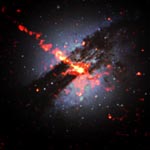
HISTORY OF LIFE
- The Origin of Life
- Earth's Earliest Life
- Sex and Nuclei: Eukaryotes
- The Evolution of Animals
- Life in a Changing World
- Extinction
- The Early Vertebrates
- Leaving the Water
- Amphibians and Reptiles
- Reptiles and Thermoregulation
- Triassic Takeover
- Dinosaurs
- Warm-Blooded Dinosaurs?
- The Evolution of Flight
- The Origin of Mammals
- Marine Reptiles
- Why Flowers are Beautiful
- The End of the Dinosaurs
- Cenozoic Mammals
- Geography and Evolution
- Primates
- Evolving Toward Humans
- The Ice Age
- Humans and the Ice Age

The Ages of The Earth
Precambrian period
3 billion-540 million years ago
The Earth's fossil record stretches over 3 billion years into the past. Using exclusively Canadian rocks and fossils, this exhibit highlights almost three billion years of early evolution when only simple, soft-bodied creatures inhabited the Earth.Cambrian period
540-500 million years ago
The Cambrian period begins the Paleozoic era. The climate is generally mild, except in North America, which is tropical. The first fossils of animals with shells and skeletons date back to this era. Only marine animals exist.Ordovician period
500-435 million years ago
North America, Europe and Africa are all together. Marine ecosystems develop. Fossil evidence shows deep water life formed during this era, and fish-like vertebrates appear.Silurian period
435-395 million years ago
Shallow flooding covers many areas, depositing sediment. Later, withdrawal of water leaves oxidized "red beds" and salt deposits. The earliest land plants, as well as the first sharks, date back to this era.Devonian period
395-345 million years ago
Europe and America collide, causing mountain building. Fish, including armored fish and lungfish, are dominant. Toward this period's end, first land animals appear and plant life becomes highly developed.Carboniferous period
345-280 million years ago
The climate is warm and moist. Severe continental collisions cause creation of more moutains, like the Urals. Ferns, fern-like trees and primitive conifers are among flora found in swamps. Insects, like cockroaches, flourish. Toward the end of this period, the first reptiles appear.Permian period
280-230 million years ago
The atmosphere and oceans cool off. Glaciation exists in the southern hemisphere. Insects evolve toward modern types, and reptiles flourish.Triassic period
230-195 million years ago
The Triassic period makrs the beginning of the Mesozoic era. The climate warms and becomes rather dry . Continental plates, joined about 200 million years prior, begin to break into continents. Fewer species exist, though in higher populations. The first dinosaurs, and possibly the first mammals, evolve.Jurassic period
195-140 million years agoNorth America and Africa separate, leaving ocean basins open. The climate is warmer than present. Reptiles dominate the land, sea and air. Archaeopteryx, an early bird, appears. The first mammal fossils date back to this period.Cretaceous period
140-65 million years agoExtensive submergence of continents leaves over-lapping marine rocks. South America and Africa separate, and the North Atlantic widens. Dinosaurs and large reptiles reach their dominance, then disappear in place of snakes and lizards. Plants and modern trees appear.Tertiary period
65-1.8 million years agoThe tertiary period marks the beginning of the Cenozoic Era. Volcanism creates the Rockies and other mountain ranges, as well as an isthmus between North and South America. Greenland and North America split. The African and European plates collide, causing more alpine creation. Archaic mammals disappear, replaced by modern horses and true carnivores. Giant apes are widespread. Also, rhinos and elephants appear, and cats and dogs begin evoloving.Quaternary period
1.8 million years ago to presentThis period begins as the great age of glaciers, which subsequently retreat. Deserts form in some areas. Many mammals, including the mastadon, become extinct. The rise of Homo Sapiens leads to human civilization and extinction of other species.
let us know for prompt corrections. Many people send us pages articles and links, any
problem contact us at This site is maintained by S.E.L.F.